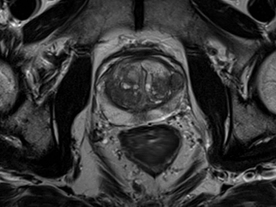by
Lauren Dubinsky, Senior Reporter | May 19, 2017

MR image of the prostate
Courtesy of Siemens Healthineers
Prostate cancer detection may be on the verge of a paradigm shift.
A new study published in
Radiology found that despite the skepticism, MR imaging is cost-effective for detecting the disease and guiding biopsies.
"Many consider MRIs to be cost-prohibitive, especially when evaluating for a common entity such as prostate cancer," Dr. Vikas Gulani, study advisor and professor at Case Western Reserve University School of Medicine, said in a statement. "This was our expectation as well, prior to doing this work, but our study found the opposite."



Ad Statistics
Times Displayed: 46577
Times Visited: 1409 MIT labs, experts in Multi-Vendor component level repair of: MRI Coils, RF amplifiers, Gradient Amplifiers Contrast Media Injectors. System repairs, sub-assembly repairs, component level repairs, refurbish/calibrate. info@mitlabsusa.com/+1 (305) 470-8013
The current standard for detecting prostate cancer involves retrieving 12 biopsy samples during an invasive transrectal ultrasound procedure. Most tumors are not visible on ultrasound images, so up to 40 percent of clinically significant tumors are missed, according to the research.
MR is more expensive, but it does a better job of detecting these clinically significant cancers. It also can reduce the costly burden of overtreatment because it often doesn't spot low-risk cancer.
A research team from Case Western and University Hospitals Cleveland Medical Center used MR to evaluate the study participants for potentially harmful lesions. They used that data and one of three MR-guided strategies to biopsy the potential foci of cancer or bypassed biopsy if the scan was completely negative.
They found that using MR to detect the lesions and guide biopsies increased standardized quality-adjusted life years for patients, and was cost-effective in about 94 percent of the simulations. The results were consistent across all age groups.
The researchers believe that these findings could help to streamline prostate cancer treatment protocols and reduce overall costs. The costs are rising and expensive; inefficient diagnostic pathways and placing patients in the wrong treatment groups are partially to blame, according to Gulani.
"If we can maximize efficiency in how we identify clinically significant lesions and diagnose patients, we can reduce unnecessary treatments for our patients, and reduce costs to our hospitals," he added.
The Barbara Ann Karmanos Cancer Institute in Detroit
announced last month that it's using a combination of 3-D MR and live ultrasound to target prostate biopsies. Their UroNav Fusion Biopsy System fuses the MR and ultrasound images.
"Previously, we used ultrasound alone for biopsies," Dr. Michael Cher, professor at the institute, said in a statement. "Now, with the fusion of the MRI and ultrasound images, we perform targeted biopsies of suspicious areas. We are better at finding cancers, and therefore better at determining the best treatment plan for each patient."
Back to HCB News

